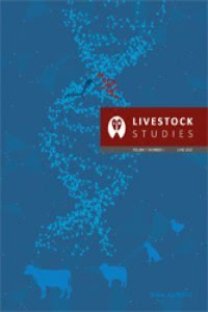ÇEŞİTLİ YERLİ SAF VE MELEZ GENOTİP KOYUNLARDA BAZI ÜREME
ÖZELLİKLERİ
Bu araştırmada Akkaraman, Kıvırcık x Akkaraman F1 (KAF1 ), Kıvırcık x Akkaraman G1 (KAG1 ), Sakız x Akkaraman F1 (SAF1 ) ve Sakız x Akkaraman G1 (KAG1 ) ile Karayaka ve Bafra koyunlarda bazı üreme özellikleri incelenmiştir. Araştırma 1998 – 2005 yılları arasında Lalahan Hayvancılık Merkez Araştırma Enstitüsü’nde yürütülmüştür. Akkaraman, KAF1 , KAG1 , SAF1 ve SAG1 koyunlarda toplam östrüs oranı sırasıyla % 95.3, 92.3, 92.5, 95.8 ve 96.4; ikinci defa östrüs gösteren koyun oranı % 14.8, 9.8, 12.8, 10.1 ve 16.1; doğum oranı % 72.7, 71.4, 77.5, 73.5 ve 72.6; en küçük kareler ortalamaları östrüs siklusu için 17.7, 17.8, 17.3, 17.9 ve 17.3 gün ve gebelik süresi için 148.9, 148.9, 149.6, 150.5 ve 151.3 gün (P<0.001) olmuştur. Karayaka ve Bafra koyunlarda yukarıdaki değerler sırasıyla % 86.7 ve 93.1; % 7.7 ve 5.7; % 60.0 ve 67.2; 17.1 gün (Bafra); 152.2 ve 150.9 gün olmuştur. Akkaraman, KAF1 , KAG1 , SAF1 ve SAG1 koyunlarda östrüs siklusuna genotip, yıl ve koyunun yaşının etkisi önemsiz; gebelik süresine genotip (P<0.001) ve yılın (P<0.05) etkisi önemli, koyunun yaşı ve kuzunun doğum tipinin etkisi önemsiz bulunmuştur. Karayaka ve Bafra koyunlarda gebelik süresine incelenen faktörlerin etkisi önemsiz olmuştur. Araştırma sonucunda östrüs ve doğum oranları ile östrüs siklusu bakımından Akkaraman ile KAF1 , KAG1 , SAF1 ve SAG1 koyunlar benzer; gebelik süresi bakımından Sakız melezleri daha yüksek değerler göstermiştir. Ayrıca ele alınan özellikler bakımından Bafra ve Karayaka genotipleri benzer olmuş, ancak östrüs ve doğum oranları bu genotiplerin yetiştirildiği Gökhöyük Tarım İşletmesi şartlarındaki değerlere göre daha düşük olmuştur.
Some of reproduction characteristics in various local pure and crossbred sheep genotypes
The purpose of the study was to investigate some of reproduction characteristics in White Karaman (W), Kıvırcık x White Karaman F1 (KWF1), Kıvırcık x White Karaman B1 (KWB1), Chios x White Karaman F1 (CWF1), Chios x White Karaman B1 (CWB1), Karayaka and Bafra Sheep. The study was conducted at the Lalahan Livestock Research Institute in Ankara between 1998-2005 years. The results for W, KWF1, KWB1, CWF1 and CWB were 95.3, 92.3, 92.5, 95.8 and 96.4 % for oestrous rate; 14.8, 9.8, 12.8, 10.1 and 16.1 % for rate of sheep showing oestrous secondly; 72.7, 71.4, 77.5, 73.5 and 72.6 % for lambing rate; 17.7, 17.8, 17.3, 17.9 and 17.3 days for least squares means of oestrous cycle; 148.9, 148.9, 149.6, 150.5 and 151.3 days (P<0.001) for gestation period, respectively. Corresponding values for Karayaka and Bafra sheep were 86.7 and 93.1 %; 7.7 and 5.7 %; 60.0 and 67.2 %; 17.1 days (for Bafra Sheep); 152.2 and 150.9 days, respectively. The effects of genotype, year and age of ewe on oestrous cycle were not statistically significant and the effects of genotype and year on gestation period were significant (P<0.001, P<0.05), but age of ewe and lamb birth type were not significant in W, KWF1, KWB1, CWF1 and CWB1 sheep. The effects of environmental factors investigated on gestation period were not significant in Karayaka and Bafra sheep. In conclusion, White Karaman and crossbred genotypes were similar each other in terms of oestrous rate and lambing rate and oestrous cycle, but gestation period of Chios crossbreds had higher than the others. All of characteristics investigated in the study were similar in Karayaka and Bafra sheep, but the values of oestrous rate and lambing rate in this study were lower than those of values obtaining from the conditions of Gökhöyük State Farm, in Middle Black Sea Region, of Karayaka and Bafra sheep
